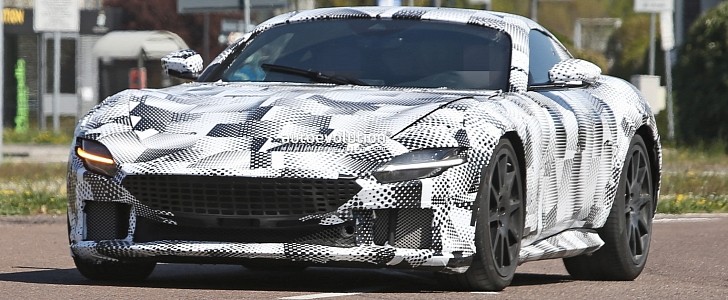Ferrari is no longer taking orders for the 812 series, and production will end altogether once they complete the existing customer orders. A successor to the model remains unconfirmed, as word on the street is that its role will be taken by the Purosangue SUV.
However, a test mule spied recently around the brand’s Maranello facility in Italy suggests otherwise, which is that Ferrari is indeed planning to launch an 812 successor. It uses the body of the Roma, albeit stretched out, with bigger wheels that likely hide uprated brakes, and a sweet burbling sound as the video embedded at the bottom of the page reveals.
You see, the Roma isn’t that sonorous, as it packs a 3.9-liter V6, with twin turbocharging, rated at 611 hp (620 ps / 456 kW) and 561 lb-ft (760 Nm) of torque. The 0-62 mph (0-100 kph) acceleration takes 3.4 seconds, making it quicker than the mighty Ferrari Enzo, and it can top out at over 199 mph (320 kph). The test mule, however, might feature an engine with twice as many cylinders under that long hood.
So, why use the Roma’s underpinnings to develop a new V12-powered model instead of the 812’s? That’s simple actually, because the brand’s entry-level model is based on a new scalable architecture, whereas the outgoing supercar builds around an older construction. Moreover, the Roma’s platform supports a variety of powertrains, including V12s and hybrids.
No one outside Ferrari knows anything about the alleged successor of the 812, yet we suspect that if it is indeed happening, then it will be more powerful than the Competizione. This variant has 818 hp (830 ps / 610 kW) and 510 lb-ft (692 Nm) to play with, produced by its naturally aspirated 6.5-liter V12. With 2.85 seconds required to hit 62 mph (100 kph) from a standstill, and a top speed exceeding 211 mph (340 kph), it certainly blurs the line between super and hypercars.
You see, the Roma isn’t that sonorous, as it packs a 3.9-liter V6, with twin turbocharging, rated at 611 hp (620 ps / 456 kW) and 561 lb-ft (760 Nm) of torque. The 0-62 mph (0-100 kph) acceleration takes 3.4 seconds, making it quicker than the mighty Ferrari Enzo, and it can top out at over 199 mph (320 kph). The test mule, however, might feature an engine with twice as many cylinders under that long hood.
So, why use the Roma’s underpinnings to develop a new V12-powered model instead of the 812’s? That’s simple actually, because the brand’s entry-level model is based on a new scalable architecture, whereas the outgoing supercar builds around an older construction. Moreover, the Roma’s platform supports a variety of powertrains, including V12s and hybrids.
No one outside Ferrari knows anything about the alleged successor of the 812, yet we suspect that if it is indeed happening, then it will be more powerful than the Competizione. This variant has 818 hp (830 ps / 610 kW) and 510 lb-ft (692 Nm) to play with, produced by its naturally aspirated 6.5-liter V12. With 2.85 seconds required to hit 62 mph (100 kph) from a standstill, and a top speed exceeding 211 mph (340 kph), it certainly blurs the line between super and hypercars.














